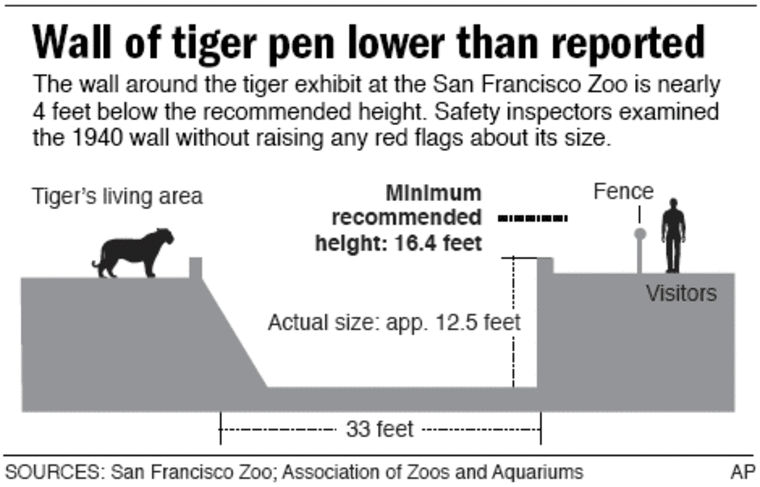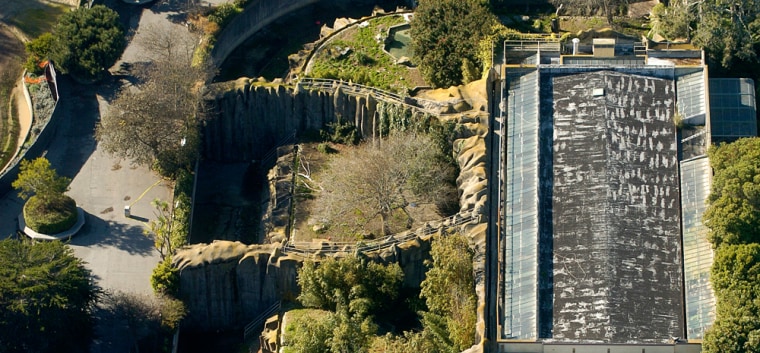SAN FRANCISCO — The deadly tiger escape at the San Francisco Zoo could prove to be a costly blow to an institution that has come under fire repeatedly in just the past few years over the deaths of two elephants and the mauling of a zookeeper.
It is becoming increasingly clear that 350-pound Siberian tiger that killed a teenager and severely mauled two other visitors in a Christmas Day rampage climbed over a wall that at 12 1/2 feet was about 4 feet below the minimum recommended for U.S. zoos by the Association of Zoos and Aquariums.
Ron Tilson, a top U.S. tiger expert and the association official responsible for the recommendation, told Reuters in a telephone interview that a Siberian tiger like the one at the San Francisco Zoo could scale such a wall.
"I've seen tigers, big male tigers, reach up to 12 feet high," said Tilson, also the Minnesota Zoo's conservation director.
Tilson said the female Siberian at the San Francisco Zoo may have jumped to latch its front paws on the lip of the exhibit's wall. That would have provided enough support for the powerful 350-pound cat to push itself up the concrete wall with its hind legs, Tilson said.
"I could understand how this female got her paws up and then just scrambled up," he said.
Accreditation suspended in 2005
Zoo officials said at a brief press conference Friday that they plan to reopen the facility Jan. 3, but they did not say whether the tiger exhibit would also be open. Also, San Francisco police Chief Heather Fong said that an investigation has determined there was no intentional release of the animal though she didn't elaborate on how it may have gotten out.
But now the zoo could face heavy fines from regulators. It could be stripped of its exhibitor license. Its accreditation could be at risk. It could be hit with a huge lawsuit by the victims or their families. It could even face criminal charges, depending on what the investigation finds.
"All this legal action is likely to impact the financial viability of the zoo," said Rory Little, a professor at the University of California's Hastings College of the Law. "Whether the zoo can stay open is a big question."
The Association of Zoos and Aquariums, which typically accredits zoos every five years, has released statements this week in support of the zoo.
The association, however, has declined to renew the zoo's accreditation before. In January 2005, the zoo lost its accreditation after a three-day inspection found a number of operational and maintenance problems. The zoo eventually received full accreditation in March 2006 after the AZA found the problems had been corrected.
San Francisco Zoo Director Manuel Mollinedo said the AZA never noted any deficiencies with the wall around the tiger enclosure.
The U.S. Department of Agriculture's Animal and Plant Health Inspection Service, which is responsible for enforcing the Animal Welfare Act, also could impose penalties, including fines, or suspend or revoke the zoo's exhibitor license if it is found that the zoo violated federal regulations on animal enclosures. Mollinedo said Thursday inspectors from the department had visited the zoo.
Legal experts said lawsuits are also likely. Already, the zoo is facing a lawsuit by zookeeper Lori Komejan, who was attacked last year when she fed the same tiger involved in the deadly escape. The animal mauled her arm.
In October, Komejan sued the city of San Francisco, seeking compensation for lost wages, medical expenses and emotional distress. She accused the city, which owns the zoo property, of "housing the tigers with reckless disregard for the safety of animal handlers and members of the general public."

The California Division of Occupational Health and Safety issued a report that found the zoo at fault for Komejan's injuries. The report said zoo officials knew the big-cat exhibit posed a hazard because the animals could reach under the cage bars. The agency fined the zoo $18,000 and ordered safety improvements.
The zoo added customized steel mesh over the bars, built in a feeding chute and increased the distance between the public and the cats.
Zookeeper's lawyer sees parallels
Komejan's attorney, Michael Mandel, said he sees parallels between Komejan's case and the Christmas Day rampage, when the tiger killed 17-year-old Carlos Sousa Jr. and mauled his friends Paul Dhaliwal, 19, and Kulbir Dhaliwal, 23.
"In both cases, there were certainly insufficient safeguards to protect both employees and the public," Mandel said.
In the latest attack, Mandel said: "I find it hard to accept the fact that they weren't even aware that the wall didn't meet the standard set by the association. They're not even aware of their own deficiencies."
Three years ago, two elephants died at the zoo, prompting it to remove its remaining elephants to an animal sanctuary. Animal activists complained about conditions at the zoo, and the San Francisco Board of Supervisors passed tough requirements that forced the zoo to extensively refurbish habitats for other animals.
Among the lawsuits that the zoo could face would be those filed by the victims and their families, even if investigators find that the Sousa and his friends had provoked the tiger or ignored warnings not to taunt the animals, Little said.
"Inevitably, there are going to be lawsuits filed," Little said. "Even if they provoked the tiger, a reasonable person would believe that the tiger could not escape. That's what you count on when you go to the zoo. You count on the idea that the animals cannot reach you."
It is also possible that the zoo could face criminal charges of negligent homicide if the investigation finds the zoo contributed to the death and injuries of the victims, he said.
The two surviving victims could also be charged with a crime if they are found to have caused or contributed to Sousa's death, even unintentionally, he said.
